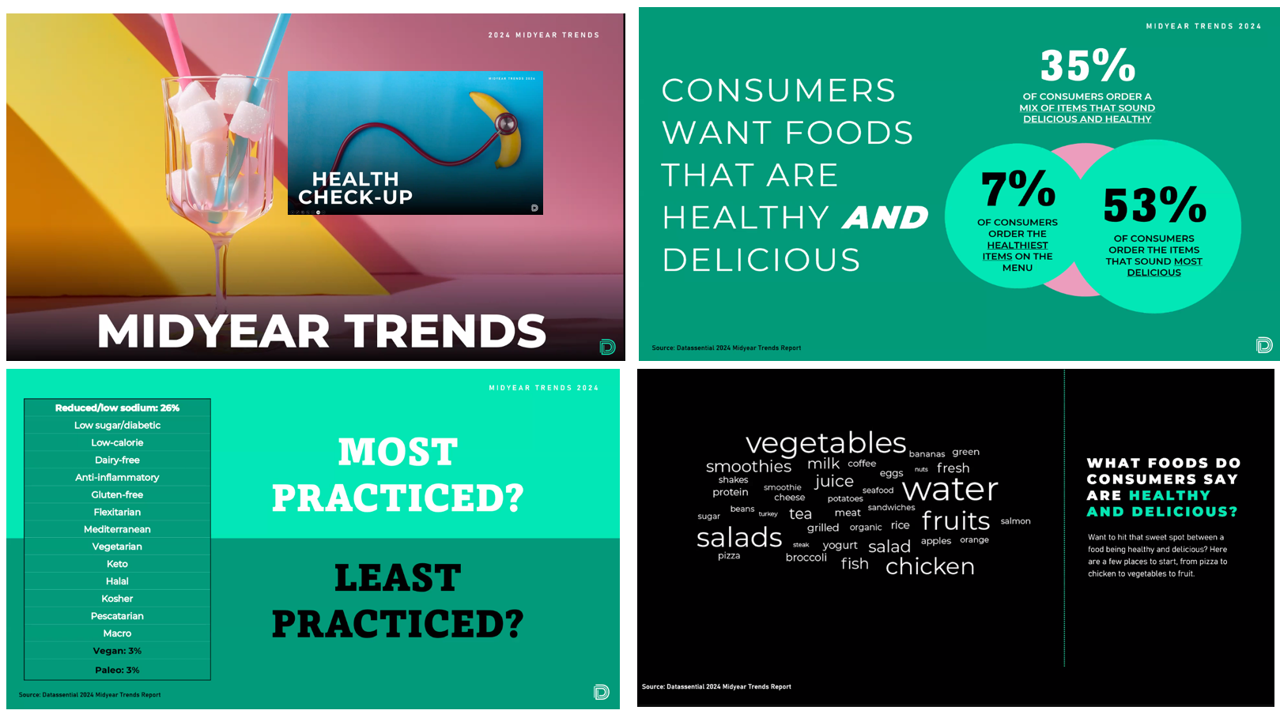The most common food-eating styles practiced by U.S. consumers are low sugar/diabetic diets, low-calorie, dairy-free, anti-inflammatory, and gluten-free, ccording to the Midyear Trends update from Datassential.

In their update on the food trends entering the second half of 2024, Datassential offered several insights on consumers and food-as-medicine in a section called the Health Check-Up.
These trends are shaping consumers’ food demands in both their grocery shopping preferences (for food consumed in the home) as well as their eating-out ordering strategies — where 35% of consumers want to see menu offerings with foods that are both healthy and delicious. Those foods consumers view as that Venn Diagram intersection including vegetables, fruits, salads, and water, shown in the word cloud diagram.

Consumers are getting more nutrition-literate, with 62% of folks reading nutrition labels at the grocery store when they see new items in supermarket aisles; and, when going out to eat, 58% of consumers take nutrition or diet into consideration when choosing a restaurant (and its menu and, often, the ingredients used to cook a dish — such as replacing less nutritious cooking oils with olive oil or, a new-fangled fat, avocado oil which was on Datassential’s trend list).

Marrying the concept of nutrition on restaurant menus coupled with the word cloud chart, note that one of the trending dishes on menus is vegetable pad thai. Datassential named this dish a second quarter 2024 Menu Winner, with 64% growth in the past year on restaurant menus, and ongoing growth over the coming years.
“With increased consumer interest in plant-based items and to keep costs down, vegetable pad thai is often being offered as the default with protein added as an upcharge,” the Datassential research revealed.
Datassential fielded the food-consumer survey in May 2024 among over 1,500 people across generations (255 Gen Z, 492 Millennials, 396 Gen X, and 358 Boomers),. The Mid-Year review also included a survey conducted with 400 U.S. foodservice operators to get the restaurant/carry out industry perspectives.

Health Populi’s Hot Points: Earlier this year, Datassential conducted research into consumers’ health perspectives, identifying major health conditions people were dealing with over the past five years. Top issues included anxiety and depression, hypertension, overweight, and high cholesterol — the latter three of which have direct relationships with food intake in terms of condition management, and impacts on mental health overall depending on food’s chemical interactions with one’s personal biochemistry.
Consumers tend to be pretty aware of weight issues, just based on how much direct-to-consumer spending is invested in the weight loss industry (e.g., see my notes on the GLP-1 market written up here).

The top reason U.S. consumers gave Datassential for not eating healthy was the higher cost of healthy food.
Payers have taken notice on the role of food in health and medical spending (and that in the context of consumers’ overall household budget constraints). The most recent example of a health plan embracing food-as-medicine and community health was announced August 8th by Blue Cross Blue Shield of Tennessee partnering with FarmboxRx.
FarmboxRx bills itself as “the leading food as engagement company who pioneered fresh fruits and vegetables as a covered health intervention”
BCBST recently published a health equity report, finding that one in seven Tennesseans are dealing with hunger and 40% of families with children are food-insecure (with 30% of parents skipping meals). Working with FarmboxRx, BCBST members will receive healthy food deliveries coupled with personalized health education focusing on a consumer’s specific medical conditions.
Ashley Tyrner, FarmboxRx’s Founder and CEO, explained that, “To narrow health disparities, we need to first tackle the social determinants of health affecting these communities. Food insecurity is a multidimensional issue – and it’s not always as simple as having access to food.”
Those multidimensional issues are a challenge to the larger health ecosystem beyond the consumer herself, her health plan, and her grocery store. As we work to fill gaps in health equity related to food security, we would be wise to collaborate across a consumers’ personal health ecology to deeply understand and appreciate the challenges and constraints she faces in daily life — from job security and mental and social health to whether she has a sufficient refrigerator/freezer in her kitchen to store healthy frozen veggies and fruits.





 Thank you FeedSpot for
Thank you FeedSpot for